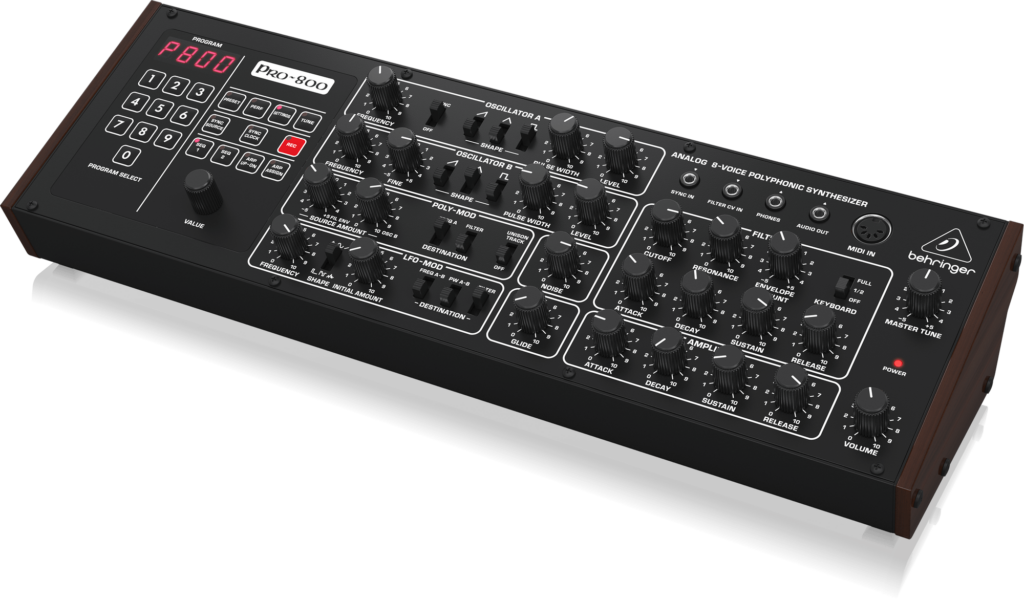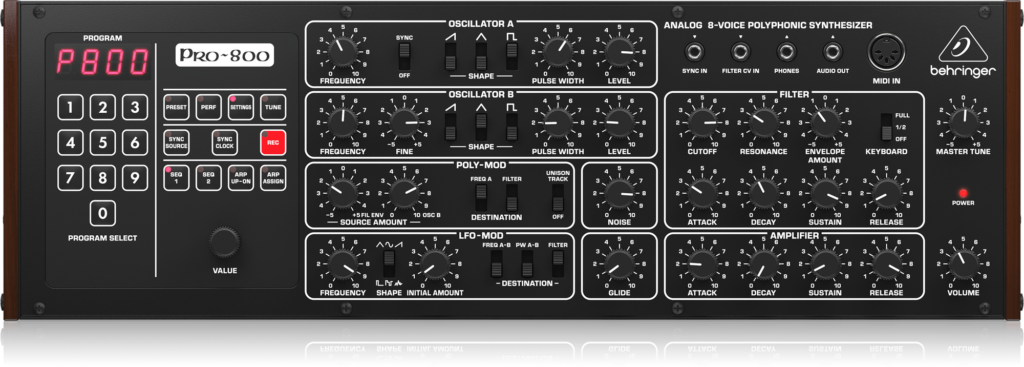Hey Folks! The new Behringer Poly Synth, the PRO-800 finally arrived at its final destination.
What does it do compared to the original? How does it sound? What are the pros and the quirks? And can I recommend this Synthesizer to you? All about it, in this video!
Intro
Yeah! This company! First I bought an overly expensive vintage synth and two days later they announced the equivalent clone. And now that the chip shortage and the economy seems to relax, they start to put out one synth after another.
And as we know our friend Uli, in order to keep prices low, there is strictly no marketing and no promo units set out upfront to us YouTubers!
As I own a lot of this channels' success to Behringer Synths, I now feel obliged to buy all this stuff!
But thankfully, as I buy all the Behringer stuff at Thomann, I can return it for 30 days, if I really don’t like it! There are affiliate links in the description, which is the best way to support us! And they are always the first to have the new Behringers in stock!
So here we go with the long awaited Pro-800:
Basically, it pretends to be a clone of the Sequential Circuits Prophet-600 introduced in 1982 as one of the first Synthesizers featuring MIDI alongside the Roland Jupiter-6.
The original had 6 voices, while Behringer made an upgrade to 8.
The Prophet-600 was never a big commercial success due to the DX-7 that came a year later, making its old school dual analogue VCO structure obsolete. Roland's Juno and Korg's Polysix were way more successful here in Europe, because they came at a considerably lower price tag. And with better Japanese built quality!
Back in the days in Germany, a new Prophet-600 cost around 5500 DM according to old price lists. A Polysix was already available for 3800-3900 DM and a Juno-6 which had no preset memory, was even cheaper around 3500 DM. The Korg's and Roland's were also available in almost every mom-and-pop music shop and sold like hot Bratwurst.
The Prophet usually had to be ordered first and was reserved for specialized synth retailers like the legendary Synthesizer Studio Bonn. (The place where Synth Hipster- and Gatekeeperism were born!)
So, all in all, it has never been a synthesizer that sparked much desire in me. I remember playing one that belonged to my colleague Francois in Paris back in the Quasimidi days. He’d amputated the keyboard and made the Prophet to a desktop model, due to its poor built quality!
So the Prophet-600, the role model for this Behringer clone, was truly no legend. For the longest time, it lived a shadowy existence as a cheap insider tip in the classified ads.
On the plus side, it had basic Midi capabilities and 100 preset memory locations. On the downside… well, let’s play some sounds first.
A lot of menus under the foiled surface!
Something that did not change with this instrument is the fact that, on the first sight, it obviously is a one knob per function synth. But there is a considerable amount of parameters hidden in the menu, which you will access via those foil buttons on the left side.
And as the Behringer Clone comes with an inbuilt modding called GliGli, there are even more parameters hidden there. So, for example you want to change the LFO shape other than the standard triangle and pulse, you have to dial a number for the parameter, which of course you have to keep in mind!, and then you can change the value with the dial.
The same applies for the global settings menu, which contains quite a lot of parameters.
So just as they did with the TD-3 Sequencer, Behringer once more clones everything exactly one to one, including all the quirky deviations.
There would have been enough space for a small display!
There would have been enough space for a small display, right? Anyway, you should always have the Quick start guide nearby! And as always, shout out to Behringer for the functional Synth Tribe App that makes a lot of those settings easier! But where is the Local-Off parameter?
The Sound:
But now to the sound: As they are good old VCOs, the two oscillators come with a beefy and powerful basic sound.
Sawtooth, Triangle and Pulse are the available waveforms and Pulswidth sounds really nice!
The signal then runs through the filter section, which I really like. This 24 dB filter cuts sharply through the entire frequency spectrum, and the resonance whistles louder than my tinnitus!
The bass cut at higher resonance values is relatively moderate compared to Moog filter circuits.
So you might think, it could be perfect for analogue drum sounds?
Nope! Definitely not! And this is also the reason why I gave up the plan to make a onesynthchallenge demo with the PRO-800! Music without drums is pointless to me!

Slow Envelopes!
Denn sie braucht schnelle und bissige Hüllkurven. Und die wirst du bei diesem Synthesizer definitiv nicht finden! Und ich weiß, wovon ich spreche, denn es war für mich kein Problem, mit dem Roland JX-8P, der oft für seine langsamen digitalen Hüllkurven kritisiert wird, ganze Drum-Grooves zu erstellen! Und schwanger wird man durch Küssen!
In the PRO-800 there are two dedicated ADSR envelopes for the Filter and the Amp, and the filter has a knob for the envelope amount. Too bad!
Last but not least, there is the modulation section: Poly Mod where you can inhale some life into your new sound creations.
LFO-Mod speaks for itself. Here, you can assign the Low Frequency Oscillator to modulate the following parameters. Unfortunately, the LFO does not sync to MIDI-Clock or trigger signal.
Yeah! There is an analogue clock input for the built-in Arpeggiator and Sequencer!
Sadly, those are completely hidden under the foliation. So I had little inspiration to go into detail in this video.
What else? On the MIDI Side, I was surprised to see that all the knobs transmit MIDI and that all the parameters can be addressed with Continous-Controllers. That’s a great plus! Makes it easy to automate it in your DAW and makes the whole menu thing a bit less painful!
The only downside to this was that I could not find a Local Off setting! That would be of great help while recording your editing in real time to a DAW!

Final Thoughts:
If nostalgia is playing tricks on you again, and you absolutely feel you have to have a Prophet-600, stop searching the small ads! Here is your dream synth: with all the quirks of the original, including the kind of "not as great as a Prophet 5"-Sound due to the impressively slow envelopes. The fact that it takes less studio real estate and comes new with a warranty is a clear plus!
On the other hand: for less than 400 Euro/Dollars Behringer offers a grown - up 8 voice analogue Polysynth, that sounds really beefy on the low end. But its specialty is undoubtedly Pads, Strings and Organs. So if you add it to a snappy analogue mono synth like an ARP Odyssey, SH-101 or a Moog style synth, you will have a great pairing.
For some, the lack of Effects may also be a downside of this synth. But before I have to complain about lousy inbuilt FX, I prefer it pure. And, of course, a 80ies inspired Polysynth-Clone should be run through a decent reverb unit. Like my recently acquired Lexicon PCM70!
So before I will end this video with some vintage Lexicon infused Behringer Pro-800 sounds for a dusty near death 80ies sound experience, I would like to thank you for spending your precious time on my channel! If you like my content, leave a like and feel free to share the videos!
And I am always happy about your comments and discussions! So what do you think? Should Behringer stick to slavish cloning of the original Synths? Or should they also incorporate meaningful improvements? Like displays or additional controls to make them easier to use?
See you in the next one! Peace and Dankeschön!

Pictures: Music Tribe / Behringer


You should update this review now that the MIDI thru and faster Envelopes are here 👍
Thanks for the reminder! I already made follow-ups on the channel!